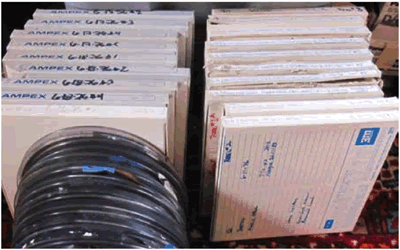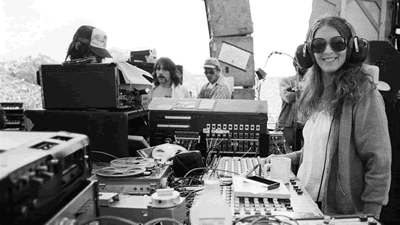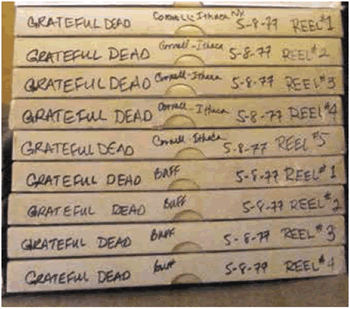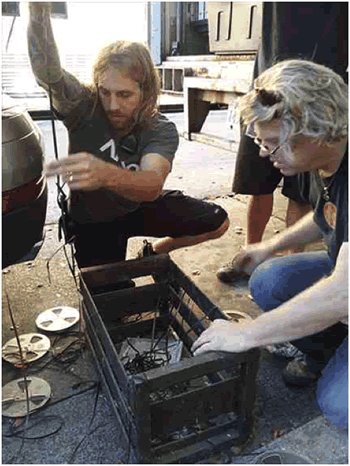
The Betty Boards saga

What's Become of
the Bettys?
The Fate of the Long-Lost Grateful Dead Soundboards
by Dean Budnick on March 11, 2014 (copied from www.relix.com
Feb. 2015)
In May 1986, a storage auction took place in California's Marin County that would altogether change the nature of Grateful Dead tape trading, the group's distribution of its live recordings and, ultimately, the Dead's place in the Library of Congress' National Recording Registry. An advertisement in a local paper drew in a few dozen curious parties anticipating the range of memorabilia and household items that typically become available through the auction of lockers that had fallen into arrears due to lack of payments. While the popularity of such events has blossomed in recent years due to television shows such as Storage Wars, back in 1986, bidders' expectations were often minimal and true windfalls were rare. As it turned out, however, on this spring afternoon, there was bounty to be had: Among the items up for auction that day were hundreds of reel-to-reel soundboard tapes of the Grateful Dead originally recorded by Betty Cantor-Jackson during a golden age between 1971-80.
The Betty Boards, as copies of these recordings became known, eventually found their way into the collections of longstanding Deadheads and newbies alike, ending some aspects of a tape-trading hierarchy by which certain individuals lorded over their collections, denying access to those who were unfamiliar with the secret handshake.
The appearance and subsequent dissemination of these recordings became a source of fascination and speculation for Deadheads in 1986 and the questions have only compounded over the years: How did the tapes fall into the auction? Who won them? How and why were they initially distributed? Are there more recordings that have yet to make it into circulation? And jumping ahead to the present, where are those tapes today? Just what has become of the Bettys?
As it turns out, the story is quite complicated and some aspects of it remain a moving target. What can be said with certainty is that a new cache of tapes has been unearthed and a plan is underway by Dark Star Orchestra guitarist Rob Eaton, who has painstakingly restored many of the boards, to complete the job and then facilitate their return to the band. Eaton hopes that a series of official releases might follow that will also yield a small royalty to the woman who recorded the reels and then lost them due to her own financial hardship, even if Deadheads owe her a debt of gratitude.
Before the auction, before the boards, there was Betty.

Betty Cantor was still in her teens when she began setting up mics and helping to record sound at San Francisco venues' first at the Avalon Ballroom and then, the Carousel (the latter during the Grateful Dead's brief stab at venue management in 1968). She worked alongside Bob Matthews, initially assisting with setups during the recording of the Dead's Anthem of the Sun. A true pioneer, as a woman staking her claim in a patriarchal business, she partnered with Matthews into the early 1970s to produce and engineer live multi- track recordings (she had a hand or two in Live/Dead) as well as studio efforts (Aoxomoxoa and Workingman's Dead).
While she worked for other artists during this period, she maintained a close relationship with the Grateful Dead, catalyzed by her marriage to crew member Rex Jackson, who would die a few years later in an auto accident. (The philanthropic Rex Foundation is named in his honor.)
'My late husband started recording on the road when he was on the equipment crew,' Cantor Jackson explains. 'He and I purchased our own gear and tape. I recorded whenever I could get to the gigs. I recorded the Grateful Dead frequently when they were at home venues, I recorded any and all Jerry Garcia Band gigs I could get to for years, in all its configurations, as well as other bands I liked whenever I could. In those days, bands were cool and happy about me getting a feed. Rex was killed in a car accident in '76. In '77 and '78, I was put on Grateful Dead road crew salary, taping and handling Bobby's stage setup.'
She later began a romantic relationship with Dead keyboardist Brent Mydland but, after that ended, she sensed that she had been frozen out. 'Brent and I split up after a few years, with the last year spent in the studio working on his solo project. This put me in the category of the dreaded 'ex.' I didn't think that could apply to me, but he was a band member. Everyone was paranoid of me being around, so I no longer had access to my studio or the vault.'
Trying times followed. In 1986, she found herself in a dire financial predicament and forced out of her home. 'All my things were moved to storage facilities. There were moving fees and storage fees. I couldn't pay,' she laments. 'I had nowhere to go so I moved to Oregon and stayed with my in-laws until I got a job with the State of Oregon as a nursing assistant.'
Unable to foot the bill at the storage center, Cantor-Jackson forfeited the rights to her worldly possessions. She remembers contacting the Grateful Dead office to inform them of the situation, but the group took no action, resulting in a public auction of Cantor-Jackson's personal assets, which included more than 1,000 reel-to-reel tapes'mostly Grateful Dead recordings, along with performances by Legion of Mary, Kingfish, Jerry Garcia Band, Old and In The Way, the Keith and Donna Band, and New Riders of The Purple Sage.

The Barton Hall boards
The majority of the 1,000-plus reels that have come to be known as the Betty Boards were acquired by three principals, none of whom were fervid Deadheads at the time. The first of these individuals set his tapes aside in a storage locker where they remain to this day. A second, who was more interested in the road cases that held the tapes, left them to rot in his barn for a decade. The final party was a couple with a particular interest in progressive rock, who nonetheless held an appreciation for the performances captured on tape.
Looking back on that day, the couple, who prefer to remain anonymous, set the scene: 'The contents of several storage lockers were being auctioned off at the same time, not just Betty's. So there were a few dozen people'the usual gang that frequents these sorts of things'milling around and bidding on lots that weren't exclusive to Betty's locker. There were probably three main players bidding for Betty's stuff, plus a lot of other people occasionally bidding on Betty's stuff and all the other stuff on display. Tapes were just a small part of what was being auctioned. There was a lot of clothing and household items set up in piles that sometimes also included some tapes. People bidding on clothing often got a couple of tapes thrown into the mix with their purchase.'
So while some tapes unquestionably were scattered to the wind, following the four- hour event and a second auction for a final lot of tapes held a few weeks later, the three prime bidders each held hundreds of reels. While two of the winning bidders had no plans for the tapes, within a few months the couple decided that they would place the music in circulation.
'Being avid collectors of bootleg recordings by numerous groups, it only seemed natural to share in the wealth,' they explain via email. 'Our Grateful Dead collection consisted of many of the common shows that were out there at the time. These new tapes dramatically expanded that collection and it wouldn't have been right not to share them. This was our way of getting new material into circulation and also breaking the hierarchy of those collectors who held on to prime shows for themselves. Initially, we started transferring the tapes to VHS Hi-Fi on our own, but soon realized what a daunting task this was going to be. So we reached out to one of our trading buddies who we knew had connections in the Dead trading community. From there, he gathered together what was later to become known as the 'Unindicted Co-conspirators,' who put in a massive archiving effort to back up the tapes and distribute them.'
The individual they selected as their point person was Ken Genetti, a friend and longtime Deadhead. 'I went into their house, and I opened up this closet and they had all the stuff arranged on a shelf in order,' Genetti reflects. 'For me, it was like King Tut's tomb. I knew immediately what they had when I looked in there. The first thing I saw was Port Chester, N.Y., Feb. 18, 1971, an incredible show which was Mickey [Hart]'s last concert for many years and I said, 'You've got to be kidding me!' Then I saw Kezar Stadium, San Francisco, Calif., '73, my favorite concert I ever went to. I pulled it out and I went, 'Holy shit!''
Genetti shared the couple's intention to spread the musical wealth, although initially he advocated for an aggressive, populist twist. 'I told them: 'You know what' It would be really great if you look in Relix and Golden Road, where there are these ads for people saying, 'Just starting my collection; please help.'' I was thinking: If only we could send out these to those people. Then, all of a sudden, those people, the newbies, would have all these tapes that nobody had. It would flip the whole scales upside down because I was so sick of these hoarders who had a whole closet of stuff that nobody could find and they would never show you what it was.'
While this didn't quite happen, with the couple's support, Genetti took the lead on distribution with the intent of bringing the music to the masses. So he enlisted three fellow tapers who lent him their decks. Then Genetti borrowed a new batch of shows from the couple (starting with the Kezar and the Port Chester reels), dubbed them and handed them off in a brief weekly tape exchange that took place in the parking lot of San Rafael's Whole Earth Access store.
At the time, Genetti had just moved onto a 120-acre plot of land north of Marin with his wife and two young children and started building a house, which added its own series of complications. 'I would get up in the morning, gas up the generator because we didn't have enough electricity to run all these things, fire it up and start recording,' he recalls. 'We did three shows a day. It was pretty overwhelming. Then at the end of the week, we would meet and I'd say, 'OK, this is what I've got for you,' and they would go from there and do whatever they wanted to with them.'
The exchange had the feel of a covert operation because the couple did not want their identities breached, and Genetti had his reservations as well.
'I wasn't trying to keep myself anonymous, but I did tell those guys, 'Look, once you have these, I want you to put them out.' I didn't want all these people calling me up saying, 'Hey, I just flew in from New York and I've got a six-pack and some pot and I'm coming over.''
As the project neared completion, the couple's anonymity was broken, at least at the highest levels of Grateful Dead management. They explain: 'We had sought to keep the operation as low key as possible because of the potential for a backlash. It wasn't until someone contacted the Grateful Dead office and offered them a copy of the tapes that we knew it was only a matter of time before we would be hearing from their lawyers. When we did hear from them, there was a bit of back and forth between their lawyers and our lawyer, but the bottom line was we had purchased the tapes legally and owned them but didn't own the rights to the music contained on them. Therefore, we could not sell the music on them, which was never our intent anyway. That pretty much left us at a stalemate and, not wanting to stir up any more issues with the Grateful Dead office, is also why we avoided re-digitizing the tapes.'
So the reels that Genetti and his team copied were the lone public clones from the masters. However, these tapes made it far and wide. The Bettys were tangible, compelling artifacts of eras in which the Grateful Dead were at improvisational apogees, including the Capitol Theatre run in 1971, the Academy of Music dates a year later and the group's fabled May 1977 tour. Beyond the performances themselves, the quality of the tapes held sway, as crisp Grateful Dead soundboard mixes were not easy to come by before 1986. Indeed there are some Deadheads who contend that the reputation of certain shows, such as the Dead's performance on May 8, 1977 at Cornell University's Barton Hall, have been augmented by the sheer number of high quality copies in circulation (culminating in the Library of Congress' selection of 5/8/77 for the National Recording Registry in 2012, even if the masters were unavailable). A case also can be made that the launch of the Grateful Dead's Dick's Picks series in 1993 was a product of Deadheads manifesting an insatiable yen for the high-quality archival recordings after they had acquired copies of the Bettys.
And here, the story might have ended, with quality tapes all around - all the more so in the age of the Internet - if not for the efforts of Rob Eaton.

DSO monitor mixer Will Popp examining moldly tapes with Rob Eaton
Rob Eaton may be best known these days as a member of Dark Star Orchestra - where he has taken on the Bob Weir role since 2001'but for many years prior to that, he served as an engineer at Manhattan's Power Station Studios, working with Pat Metheny, David Crosby and Kronos Quartet among many others. His studio skill set served him in good stead when the person who had acquired the second batch of Betty Boards contacted him.
In late 1995, Eaton received a call from a high-school teacher who had purchased one of the lots predominantly for the road cases that held the tapes. The teacher now hoped to sell the reels and wanted Eaton to assess them. In a cluttered barn, Eaton discovered a grimy, mold-infested collection.
'Out of 200 tapes,' he remembers, 'only six boxes were legible and 75 to 80 tapes had no boxes at all'they had completely disintegrated from rot.' Still, Eaton believed he could resuscitate the reels, which he soon confirmed were part of Cantor-Jackson's original collection. Eaton was staying with his friend Dick Latvala, the Grateful Dead archivist until his passing in 1999. 'I spent all night long with some tools and cleaned up a portion of one of the reels. It was a reel from 9/6/73 - a Garcia-Saunders show from the Capitol Theatre in Passaic that no one had ever seen before. So we knew this was a legitimate stash of tapes.' The teacher eventually hired Eaton to restore his collection, exchanging 40 tapes at a time via the mail.
This might have been the end of the story, but the Betty Boards have proven to be the gift that keeps on giving. The teacher never found a buyer for the tapes - his asking price was a million dollars - and two years ago, facing monetary struggles and fearing that that the bank might foreclose on his home, he contacted Eaton once again to see if he would be willing to take custody of the tapes. The teacher also explained that he had discovered another 50 reels while cleaning out the barn.
Eaton assented and on a day off during a Dark Star Orchestra tour, 'I went to meet him at a parking lot of a Denny's. He had a pickup truck and a trailer full of excrement and hay and the boxes I'd originally sent him back plus a wooden crate with 50 seven-inch reels thrown in it - no boxes, all tangled up. It was a complete mess. But most of those tapes turned out to be amazing. I would say 22 of those were from the June '76 tour - stuff that I had not seen before.
'If you had looked in the box, you would say there was no way they can be recovered but they could, if you took the time to do it. The challenge is that you can't play them until you bake them at a low temperature for an extended period of time. That reformulates the back coding, which is what the oxide is on, and the oxide is what the music is recorded on magnetically. The seven-inch reels were on plastic hubs but I couldn't transfer those to metal reels because it would ruin the tapes. So I modified a food dehydrator that I use to dehydrate mushrooms I collect here in the mountains of Colorado in the summer time.'
Eaton also went so far as to have a friend refurbish Betty's Nagra IV-S Reel to Reel on which she recorded these shows, so that he could digitize the sounds of the tapes played back on the original machine that produced them.
Emboldened by success with this latest batch, Eaton set a new goal for himself: 'I had this dream to try to reclaim all of this music and archive it properly so that it's there for generations to come in the best possible form.' So through a chain of contacts, he eventually located Ken Genetti, who agreed to pass along a letter to the couple.
'Two months later, I got an email out of the blue,' Eaton remembers. 'They said they'd be interested in restoring their tapes and archiving them properly. They also said there were a lot of tapes that hadn't been touched. So the next time I was in San Francisco, I loaded up their tapes onto the semi tractor- trailer that DSO owns and brought them back East.'
But it didn't end there. While completing his work on the couple's reels, Eaton began researching the original auction, hoping to identify the third individual who had purchased the Bettys. He eventually found him, and in January 2014, the pair entered into discussions about this final batch of tapes, which Eaton hopes to restore.
What then? Eaton has a plan that he already has set in motion. 'What I'd love to see done - 'in a perfect world - 'is I think all the tapes need to go back to the vault,' he says. 'I think the people that have purchased these tapes should be compensated. I don't think we're talking huge sums of money but enough to make them relinquish the tapes back to the Grateful Dead. They should be part of the collection. Another thing that's important is if these tapes do get back to the vault, Betty should get her production royalty on anything that gets released, which is completely reasonable. Those were her tapes; those weren't the Dead's tapes. I'd love to see Betty get her due.'